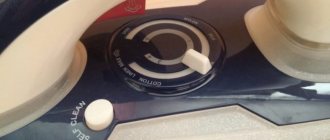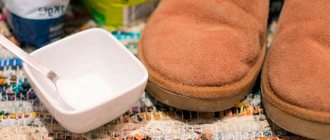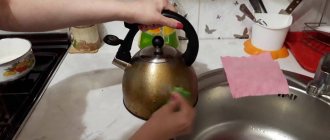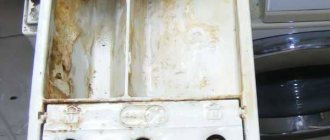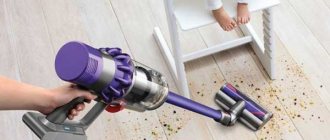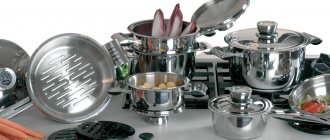April 23, 2014
At TSK TULAVAR we believe that the traditional samovar is the most important attribute of home gatherings with the family. Shining and important, it always pleases the eye and soul. But, like any other household item, it requires proper care, even if it is not used for its intended purpose. Sooner or later, the surface of the samovar becomes covered with stains, plaque, oxide, and unsightly stains; the body must be cleaned of scale and carbon deposits (in the case of fire-heated samovars).
How to clean the outside of the samovar without spoiling it worries many owners of this household utensil. The cleaning method will depend on what material the samovar is made of, in order to take into account the chemical and mechanical compatibility of the cleaning agent with the surface of the product.
Features of cleaning different materials
For each samovar there are certain recommendations and cleaning products. It is important to follow them, otherwise, after treatment with an unsuitable device, the design of the heating device may even break down. In addition to the fact that the inner and outer walls will not be cleaned, if the wrong product is used, they may become discolored or cracked. It is also recommended to use several sponges and rags for cleaning.
How to clean a brass samovar
Usually, when cleaning brass samovars, ammonia or oxalic acid is used. When cleaning, use a soft sponge and a dry cloth. Do not use chemical or sandy products under any circumstances, as traces will remain. After you have treated the samovar with acid or alcohol, wipe it thoroughly with a dry cloth, otherwise oxidation will occur.
How to clean a copper samovar
Copper is a soft metal, so only use soft materials. A copper samovar should be wiped with a dry cloth. For the perfect shine, use a squeeze of fresh lemon. Wipe the walls in a circular motion, and use kerosene for hard-to-reach places. Wet the swab and thoroughly clean the desired area. After a while, wipe everything with a dry cloth.
How to clean a stainless steel samovar
Stainless steel can maintain its appearance for a long time, but to do this it must be cleaned regularly. When using powdered products, marks will remain on the walls and the shine cannot be restored. Use a soft cloth and gel dish detergent.
After cleaning with chemicals, you need to boil water several times and pour it out. For greater shine, wipe stainless steel with a dry, lint-free cloth.
Faience and porcelain
Porcelain products contain clay, so when using chemicals, cracks may appear. The outer layer of a faience samovar consists of a glaze that can maintain its shine for a long period, but to avoid reactions, use laundry soap. After processing, rinse the samovar with a wet sponge and wipe with a dry cloth.
How to clean a nickel-plated samovar
Nickel is less sensitive to chemicals than chromium, but its appearance can also be easily spoiled. For cleaning, use substances that are sold in specialized stores.
At home, you can make your own mixture of salt or vinegar. Powdered substances must be dissolved in warm water so that no grains remain. Then the liquid must be cooled and only then used for cleaning.
Chrome plated samovar
The chrome-plated surface of the samovar quickly loses its presentation if not properly maintained. Use store-bought products or mix salt and vinegar to a paste consistency. Coat the entire samovar with it and leave for 30–40 minutes. Then rinse the mixture with water, wipe with a rag and rub until shiny.
Aluminum
A samovar made of aluminum is lightweight and durable, but you won’t achieve the shine of chrome. Soft metal indicates the impossibility of using powdered products. However, aluminum is easily subject to oxidation, so use only appropriate mixtures. The best of them would be an alcohol solution and wood ash.
Gilding
Such samovars are least susceptible to physical damage, so standard detergents can be used. Also, gold plating is less sensitive to oxidation and can be washed with almost any homemade solution.
To effectively clean all small parts, fill your bathtub with warm water and add detergent. Place the samovar for 2–3 hours, rinse, and then dry thoroughly and rub with a cotton napkin.
Preparation
Samovars are mainly made from the following materials:
- brass;
- copper;
- stainless steel;
- cupronickel;
- nickel;
- aluminum;
- faience.
Expensive samovar models are available with chrome or gold plating. When choosing a cleaning product, it is important to consider the material of manufacture. This is explained by the fact that metals react differently with different chemicals.
This recommendation also applies to the choice of folk remedies for removing scale and soot.
How long ago was it made?
The choice of cleaner depends on the date of manufacture of the kitchen appliance. If a copper samovar was created a long time ago, then it is recommended to remove the plaque from such a product from the inside: the patina covering the outer walls gives the effect of antiquity. In addition, older appliances require more aggressive cleaning agents that can penetrate deep into the material.
Material of manufacture
As mentioned above, samovars are made from different materials, each of which has its own requirements, both for care and for cleaning products.
Disassembly
Complete disassembly will be required if there is a need to restore individual components of the samovar. To clean, you need to remove the top cover to gain access to the inner walls, as well as the key, handles, crown and stand.
How and with what to clean the samovar
The samovar has long been considered an antique, so it is quite difficult to find special means for cleaning it. However, you can achieve the desired effect at home using ordinary folk remedies and cleaning products.
Vinegar + salt + flour
Mix salt and flour in equal proportions, stir and pour in a little vinegar. You should get a thick mass that needs to be applied to the samovar and wiped with a sponge. Then rinse everything off with water and wipe with a dry cloth until it shines.
Lemon or citric acid
Citric acid cleanses the surface well from stains and plaque. Cut a slice of lemon and rub the walls of the samovar. Then use a toothbrush or a stiff sponge to thoroughly clean the device. Rinse everything off with water and wipe with a dry cloth.
Vinegar
Before using acetic acid, wear protective gloves and try not to splash it. Wet a swab or napkin and apply the liquid to the surface of the samovar. Rub it with a sponge or toothbrush. Then rinse with water and dry with a cloth.
Ammonia
Ammonia is used in the standard way: soak a rag or sponge in it and rub the samovar from plaque. After the procedure, rinse everything with water and wipe with a dry cloth.
Oxalic acid
The substance must be used with protective gloves. Mix the acid with water in proportions of 100 g per 3 spoons. Apply the thick paste to the samovar and leave for 30–40 minutes. Then mix a spoonful of baking soda in a glass of water and wipe the device. Rinse everything off with clean water and rub until shiny.
Paste GOI
GOI paste can be used for polishing brass and copper samovars, which are easily scratched and lose their shine. Apply the paste to a sponge and wipe all areas of the water heater. Then clean the walls of the substance with an alcohol solution and rub thoroughly with a dry cloth.
Coreg tablets
The tablets are intended for cleaning dentures, but they are also used for treating samovars. For maximum effect, use a large container large enough to accommodate the samovar. Pour hot water, add a few tablets to it and wait until they dissolve. Then place the samovar there and wait 2-3 hours. The longer the samovar is in the solution, the stronger the effect will be. Then take it out, treat it with soda solution and rinse with water. Rub with a soft cloth until shiny.
Sweet sodas
Carbonated drinks are used to clean the inner surface of the samovar from scale. Pour Fanta, Pepsi or Sprite into the samovar and leave for one night. In the morning, pour out the liquid and brush the walls. Then rinse with water and wipe with a dry cloth.
Potato peelings
One of the oldest and most effective ways to clean the inside of a water heater. Throw the potato peelings into a samovar with water and boil for 40 minutes. Then leave to cool for 2-3 hours and pour out the contents. Rinse with soda solution and treat with a stiff sponge or toothbrush.
Soda ash for keys and faucets
This option is designed for cleaning small parts of the samovar. Remove them from the structure and place them in a container of water. Then add calcined salt and boil for 30-40 minutes. Let the parts cool and rinse them with clean water. Place the key and taps on a dry towel until completely dry.
Cleaning stainless steel surfaces
Stainless steel cookware loses its luster over time, becomes dull, and becomes stained. There are several options for cleaning a stainless steel samovar. The most commonly used are Goya paste and vinegar, available in every home.
Vinegar
Using vinegar is very simple:
- moisten a cotton pad or swab with 9% vinegar;
- wipe the surface.
Paste GOI
In addition to stainless steel, Goya paste can be used to clean copper samovars and brass products. It can not only clean, but also add shine:
- put a little paste on a soft cloth;
- clean the product;
- Remove residues with alcohol.
Important! Apply the paste gradually - after cleaning one area, apply it to another area.
How to clean a samovar from rust
Let's look at ways to clean corrosion on samovars made of different metals:
- Copper. Despite the fact that non-ferrous metal does not rust, when oxidized, a corrosive coating may appear on it. To remove it, use a paste with salt, flour and vinegar. Apply the mixture to the affected area and leave for 30-40 minutes for a chemical reaction to occur. Then we wipe everything with a rag and moisten the surface with citric acid. Rinse with water and rub with a dry cloth.
- Brass. Samovars made of this metal are more susceptible to rust, so if there is constant corrosion, change the storage location of the samovar, with a lower percentage of humidity. The best means for recovery would be ammonia, tooth powder and distilled water. Mix the ingredients and apply the finished mixture to the affected areas. Leave the samovar in a dark place for 1.5-2 hours for the reagents to react with corrosion. If rust remains, then repeat the procedure. Rinse off the solution with water and soda, then wipe everything thoroughly with a dry cloth.
- Nickel and chrome. The use of acidic substances is excluded, since the chrome plated metal will tarnish. To remove corrosion from such material, it is better to use special pastes. Alternatively, you can use a saline or soda solution. If not all rust has been removed, then use fish oil. After applying to the affected area, leave the samovar for 24 hours, then wash off with water and detergent.
- Aluminum and gold plated. Pure aluminum can be restored with an alcohol or vinegar solution. For greater effect, add sodium tetraborate to the liquid. If the walls are covered with gold, then mix sodium hypochlorite with egg white. Apply everything to the affected area and leave for 5-7 hours. Then rinse with water and wipe until completely restored.
Kinds
According to the principle of operation, ancient samovars are wood-burning, kerosene, or combined. They need to be cleaned of soot. Today's products are mostly electric and work on the principle of an electric kettle.
The process of cleaning a samovar at home should begin with an assessment of the product, because the choice of cleaning products and methods depends on the age of the product and the material used in its manufacture. Antique examples are often made of brass or copper and have a reddish or yellow tint. Products made from cupronickel are less common. Retrofitted ones are in most cases made of stainless steel or nickel-plated brass.
How to get rid of scale in a samovar
The best descaling agent is citric acid. For maximum effect, follow these instructions:
- Fill the samovar reservoir with water and bring to a boil;
- add 100 g of citric acid;
- leave for 3-4 hours;
- Boil the water again and let it cool;
- pour out the contents and evaluate the result.
If the scale is not completely removed, then repeat the procedure. The remaining layers are easily removed with a sponge. After this, rinse the tank with water.
A similar method is the use of acetic acid. In some cases, it is more effective than lemongrass, but it leaves behind a pungent odor. The removal procedure occurs by boiling water with vinegar.
Folk remedies
In most situations, to restore the shine of brass products, it is enough to use traditional methods. The means at hand allow you to clean objects, regardless of their shape and size, without much expense.
Oxalic acid
A simple detergent, one of the ingredients of which is oxalic acid, is suitable for treating brass. The substance must be applied to a sponge, carefully treat the brass surface with it and wait for the reaction to appear. When exposed to acid, a small deposit will begin to form, which can be easily washed off under the pressure of water with a brush. After washing the product, you need to sprinkle soda on it, after 20-30 minutes, wash it again and rub it until shiny.
If it is necessary to perform deep cleaning, make a mixture of oxalic acid and warm water, observing the proportions of 200 g per 10 liters. An acid solution is prepared in a deep container, a contaminated object is placed inside, until it darkens and washed. This method is suitable for combating old stains caused by the oxidation process.
Acetone
Simple acetone can also restore the brass alloy to its original appearance. Acetone in its pure form or as part of a nail polish remover is suitable for cleaning. A cotton pad or soft sponge is generously moistened in the liquid and, applying force, wipe the stains on the product. You can use a similar method to clean copper objects.
Toothpaste
A common folk technique is the use of abrasive cleaning agents, including toothpaste. Squeeze a small amount of paste from the tube onto a toothbrush or rag and wipe the dull areas on the coating until the stains are completely removed. To achieve an effective result, you need to first wash the brass product in soapy water to remove stains that have arisen for other reasons (old grease, dirt, adhering dust).
Vinegar
Only recently appeared stains can be removed with undiluted vinegar. Heat the vinegar on the stove and wipe the brass with it. To clean a product with old stains, you need to dilute half a glass of vinegar and a tablespoon of salt in 2-3 liters of water. This mixture is heated to boiling point. When the solution boils, place an object inside and boil for 3-4 hours, periodically adding evaporating water. During a long boil, all stains will be washed away, and all that remains is to rub the surface to restore shine by polishing.
Lemon acid
Citric acid granules are sprinkled onto the brass coating and rubbed vigorously into the contaminated areas. You can also make a cleanser using half a lemon and a pinch of salt. The lemon is thoroughly coated in salt and the dark spots on the product are smeared. This method is suitable for removing both recent and old oxidation.
Emery
Sandpaper is used to clean large products with a large volume of oxides. For example, you can sand a brass basin or fireplace grate
It is important to consider that after rubbing with sandpaper, the product will lose its original shine, so you should resort to this method for items that do not require special handling. Brass jewelry, decorative items and rare items are cleaned using other means.
Soapy water
Newly appeared oxide stains can be removed with a soap solution. It is recommended to use laundry soap, which effectively cleans the brass surface. You can rub in soapy water using a soft cloth or sponge.
After soaking, the brass is rinsed with clean water, wiped and polished to restore its original shine.
Salt
You can clean brass with fine salt, which is mixed with low-fat cream. The mixture is applied to the oxidized areas and rubbed in. To treat old stains, it is recommended to pre-soak the mixture for an hour.
Vinegar dough
Using vinegar, a common method for processing sour dough is. It is suitable for application to products containing copper. The method is as follows:
- Mix 1 cup of flour and 0.5 cups of warm liquid and vinegar.
- The oxidized areas are covered with the resulting dough with a thick consistency and left to dry.
- After the dough has dried, it is carefully torn off the surface and the product is polished with a soft cloth.
As an additional measure, you can treat the product with a polishing agent. This will help restore the shine of the product.
How to clean a copper samovar from green deposits
Copper often develops a green coating called patina. There are several methods to remove it:
- Lemon juice. Cut the lemon into slices, treat the affected surface with them and use a toothbrush or sponge with a hard surface. Then rinse with clean water and rub until restored.
- Soda. Pour 0.5 liters of water into a container and add 1 tablespoon of baking soda. Apply the solution to the affected areas until the green color begins to fade. This substance is also good for cleaning faucets and samovar keys. They need to be put into the solution and left to sour for 3-4 hours.
- Vinegar. We wet a piece of cloth in 5% acetic acid and treat the damaged areas with it. There is no need to apply force, just apply the liquid to the surface. After achieving the result, wash everything off with clean water and wipe with a dry cloth.
Universal ways to polish a samovar to a shine
A samovar that has not been cleaned for a long time will first have to be washed with a detergent solution. You can use universal dishwashing detergent, a solution of soda ash or baking soda. Previously, products were polished with sand, after which they “burned,” but scratches appeared on the surface, which accelerated the appearance of patina and oxide deposits.
Any samovar can be cleaned with tooth powder or chalk crushed into dust. These fine abrasives are good at removing plaque from the surface without damaging it.
Heavy stains are removed with gasoline, GOI paste, Metalin, a mixture of 1 tbsp. l. table salt and 1 cup whey. Polish the pre-cleaned surface with a piece of felt or flannel soaked in the selected composition. A brilliant result can be obtained using newspaper.
How samovars were cleaned in ancient times in Rus'
In the old days, the samovar played an important role in every home, so it was regularly wiped until it shined. Sorrel leaves were most often used. They were taken in a bunch and squeezed, then the samovar was wiped. In winter, fresh sorrel was impossible to find, so frozen cranberries were used. They were defrosted over the fire and the walls of the samovar were rubbed in a circular motion. A little later, salt, clay and chalk came into play.
The samovar was once the main thing in the kitchen of every family. Today it is used more often by lovers of antiques, although its tea-brewing qualities are in no way inferior to modern devices. If you suddenly decide to purchase or take a samovar out of the pantry, then do not worry about its appearance, because there are a large number of methods for cleaning it and polishing it to a perfect shine.
Folk remedies
You can use folk remedies to clean both internal and external surfaces. The most popular are:
- vinegar;
- lemon;
- toothpaste;
- coca-cola;
- dentifrice.
You can clean the outer walls until they shine using toothpaste or tooth powder. The principles of action of these substances are no different. When using toothpaste, it is applied to the outer surface of the dirty area and rubbed in. The powder is also used, but before this the outer surface is moistened with warm water. Residues of teeth cleaning products must be thoroughly rinsed off the outer surface, then polish the outer walls with lint-free wipes or pieces of cloth.
Toothpaste will help you clean the samovar until it shines.
A simple drink of Coca-Cola can clean the inside of a samovar. This is a very aggressive product, used only in cases of severe contamination. It helps remove scale from the heating element. This is done as follows:
- Coca-Cola is poured inside the samovar in an amount to completely cover the heating element (plus 2-3 cm).
- Then the samovar is heated for 15 minutes.
- After this, you should cool the Coca-Cola directly in the samovar. When it cools, it is poured out and the internal surfaces are cleaned.
When using lemon, wipe the inner surfaces of the walls. This way they are cleaned of a thin layer of scale. Cleansing is carried out as follows:
- Lemon is cut into thin slices.
- The inner walls are wiped with slices.
- To purify, one portion of water is boiled idle.
If desired, you can use freshly squeezed lemon juice. A cotton wool is moistened in it and the walls are treated.
Lemon will help cope with many impurities
You can also clean the samovar using vinegar. It is advisable to choose 6 percent. In its absence, you can double the cleaning time with three percent, but it is better not to use nine percent - it is too concentrated. A piece of cotton wool is soaked in the essence and the surface is wiped with it. Wipe the outer and inner walls until shiny. The more soiled, the more cotton swabs you will have to change.
Household products
Household products are also used to clean samovars. The most popular are:
- liquid laundry soap;
- dishwashing detergents;
- soda solution;
- solid laundry soap;
- dishwashing powders.
Some types of samovars cannot be cleaned with abrasives. These include dishwashing powders and baking soda. What materials cannot be cleaned with abrasive particles are described in the sections above.
You can use laundry soap to clean external dirt such as grease stains or food stains. In this case, liquid laundry soap is applied in a thin layer, and a sponge is soaped with solid soap, which is used to treat the surface. Contaminants should be cleaned using hot water or even boiling water - this way they will come off better. Remaining soap should be rinsed off thoroughly.
It is not recommended to clean internal surfaces with laundry soap. They will not be able to remove scale on the walls or heating element. In addition, the smell of soap is difficult to dissipate.
Dishwashing detergents are used in the same way as liquid laundry soap. They are considered the best for cleaning stainless steel samovars. The stainless steel device can be cleaned with dishwashing detergent both outside and inside. It is advisable to choose products that are odorless. Otherwise, it is necessary to leave the samovar open, and also boil 2-3 portions of water after cleaning. Dishwashing detergent will not be able to remove deep layers of scale. It helps remove thin greasy deposits or film on the inner walls.
Soda solution can be used in combination with other ingredients or alone. For independent use, a small amount of baking soda is mixed with a few drops of water. For one teaspoon of baking soda, one teaspoon of water is enough. This mixture is applied to the outer walls of the samovar, the material of which allows it to be cleaned using abrasive particles. Then, using a kitchen sponge or scrubber, baking soda is used to remove dirt from the outer walls. It is not recommended to clean the inner walls with soda, and it is prohibited to use soda on heating elements.
Cleaning the samovar both inside and outside is possible using improvised means. In this case, the material used to make the device and the location of the contaminated parts are important. With timely cleaning, you can extend the service life of even vintage devices for a long time!
An effective samovar cleaner
General recommendations
You can avoid the appearance of burning in rooms with a fireplace or stove, provided that you follow the rules for using heating facilities
It is important to clean chimneys on time. To do this, burn off the soot with aspen firewood, potato peelings or salt.
You can also purchase special products for cleaning pipes from soot.
Ammonia is used to remove soot from surfaces. It is added to water during wet cleaning. Ammonia, together with baking soda, added to water will help get rid of the acrid smell of smoke and burning. At the end of washing the apartment, you should use a sealant. It is applied to the walls, then primed. They do not forget that they begin freeing the house from soot and soot with dry cleaning, only then doing wet cleaning.
Share link:
